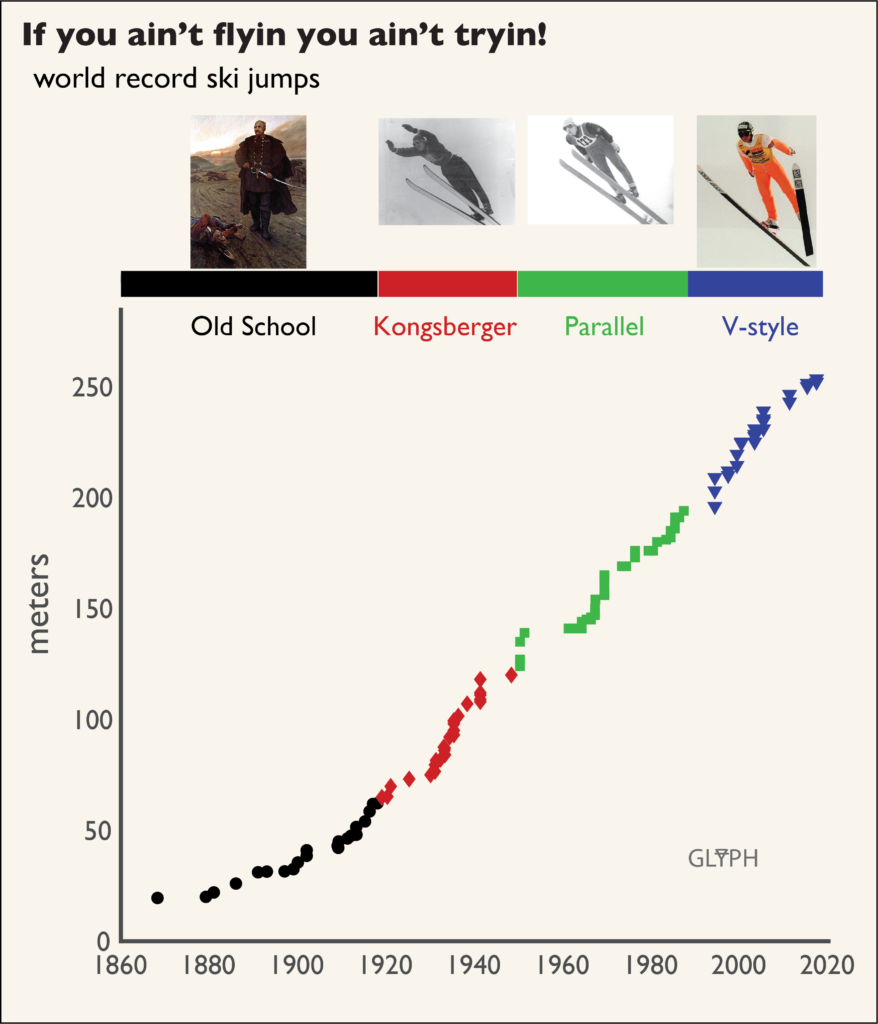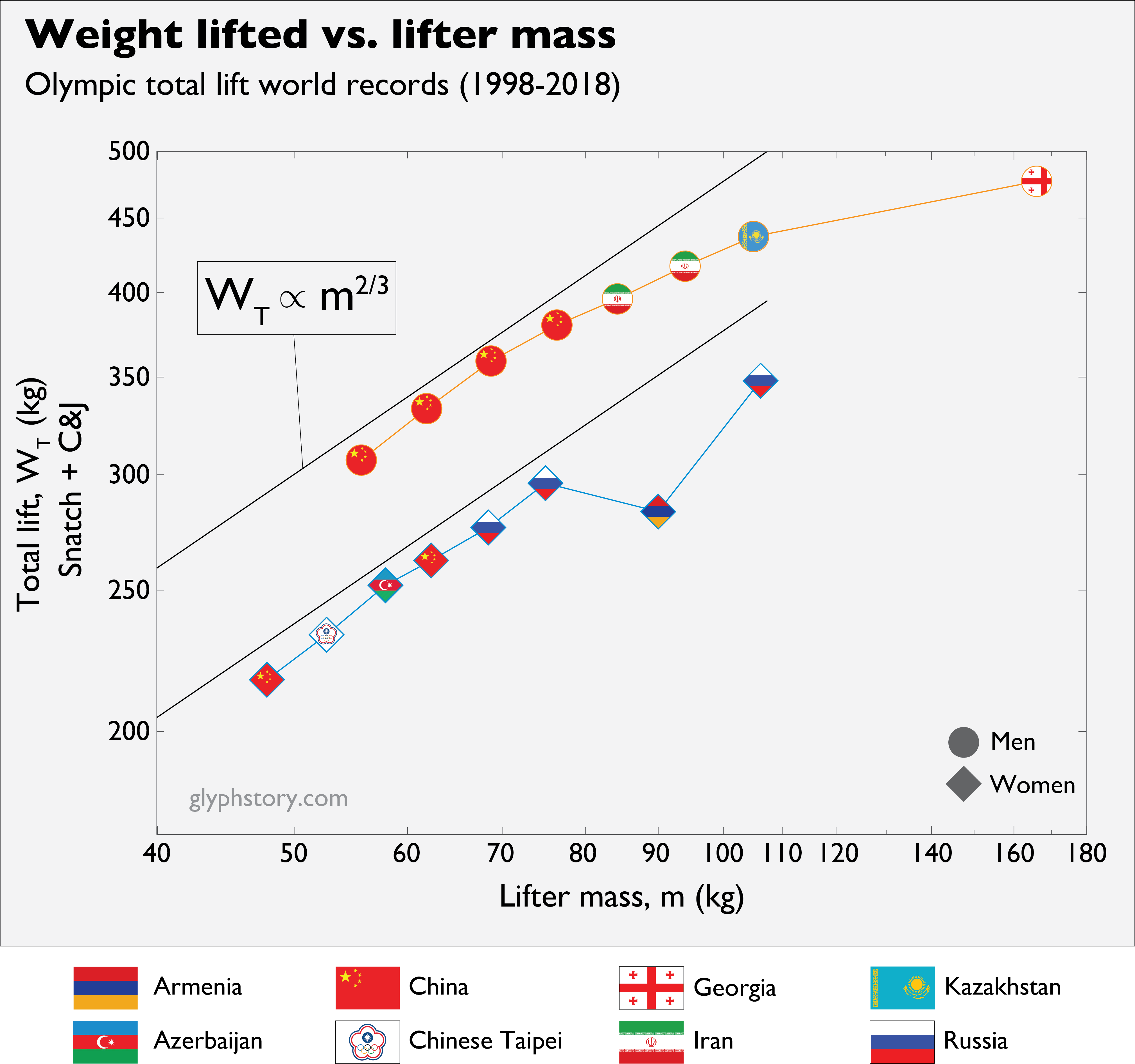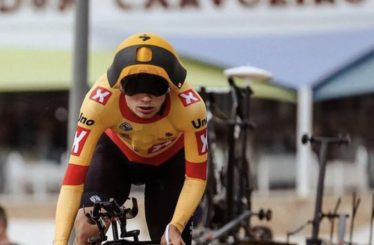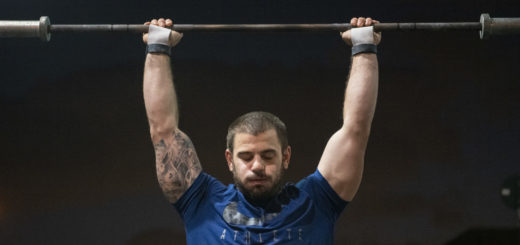A brief history of contrived records, part 2
Hold my sword. Me and this mustache are going to do something worth writing down.
Olaf Rye, probably1

The ski jumping discussion originally intended for this space was going to deal with a technical change that jumpers made within my memory. In the early 1990’s, jumpers moved from the parallel style (green points) to the V-style (blue points). This change in style was partially driven by a change in judging. Jumpers had known for some time that the V-style improved distance, but it was considered bad form and the style points lost did not make up for the improved distance. A series of crashes in the late 1980’s probably helped change the judging criteria. In addition to improving distance, the wider V-style also increases the roll stability of the skier, so that momentary lift perturbations less quickly become catastrophic.
That was the story I half-remembered from watching the 1992 Olympics as a child. It’s basically right, but it elides the incredible historical richness of contrivance within the records environment for ski jumping. To get into this, we have to first make a distinction between ski jumping—the thing that you see quadrennially on NBC—and ski flying, which is a distance-focused variant considered too gauche for the Olympics. Ski jumping doesn’t really keep distance records, the points awarded being a function of distance and style. The distance is further adjusted within a given competition by gate adjustments for wind and conditions. I’m going to use the terms more-or-less interchangeably from here on.
The critical difference is that the hills used for ski jumping are not as large as those in the flying competitions. In both disciplines, the hills the athletes are landing on are built with an effective maximum distance, at which the slope of the hill flattens out and the ground comes up to meet the skier. The need for a maximum distance is partially just a function of geology: mountains aren’t infinitely tall, so you can’t keep a constant slope forever. Because the skis used by jumpers are kind of wide and unwieldy, you also want to give them a flat runout to stop on, ideally without them having to ski another 1000 feet. And finally, the longer you let them fall, the more time Mistress Gravity has to turn them into a missile.
The latter reason basically dictates the biggest hill you can build. If skiers aren’t good enough to handle the launch speeds, ground-normal velocities, and flight times needed to jump 300 meters, you cannot in good conscience build a hill for 300 meter jumps. So there is a back-and-forth that takes place between increasing athlete skill and hill construction–if athletes show that they can handle jumps of 250 meters, hills will be enlarged to let them try 260 meters.
Viewed in this light, the record history for ski flying is almost entirely contrived, but like Kipchoge’s 2-hour run over the marathon distance, it’s no less impressive for the contrivance. I don’t have a great image of what happened before the Kongsberger technique became popular, so the exemplar of the old school is Olaf Rye. Olaf holds the first record (9.5 m in 1808) which is left off the image to tighten the abscissa. Olaf later became a general and died in battle, so he has a variety of things named after him in Denmark and Norway now which presumably have nothing to do with his skiing.
The start of the Kongsberger era (1919 in the plot) might be a little early, since the best information I can find2 states that it became popular after World War I. There is a video from what appears to be the 1936 Olympics in Garmisch-Partenkirchen of the Kongsberger technique. The still picture doesn’t really do justice to the vigorous arm-flapping involved, and you get a sense of why you would want to award style points for things like, “Least obvious display of butt-clenching”. This era sees the first of several near-vertical sections of the curve, corresponding to rapid bouts of record breaking. In 1941, some German skiers in (occupied) Yugoslavia used the recently-improved hill at Planica to raise the record four times in one day.
You see a similar phenomenon at the beginning of the Parallel era, this time at Oberstdorf, Germany. The Planica hill, then the Oberstdorf hill were improved in steps starting in the late 1960’s, leading to more leaps in the records. By 1986, the record stood at 191 m, more than 60 m farther than at the end of World War II. It was still moving upward in occasional leaps, with Matti Nykanen extending it three times in two days in 1984, and twice on one day in 1985. At the 1986 Ski Flying Championships in Kulm, there were enough accidents to spook the FIS into a rules change that discouraged record-chasing for a few years.
The V-style got some traction after that, in part because of its improved roll stability, and that more-or-less brings us up to the state of the art.3 What might be lost is the extent to which the record has improved within each technique, simply because of the hill size and the concomitant skill of the athletes. For the 25 years of the V-style’s ascendancy (1994-2019), the record has moved from 196 m to 253.5 m, a 29% increase. By comparison, the record in the men’s long jump has moved by 17% since 1901. A 29% increase in the men’s long jump since the turn of the 20th century would mean that someone would have jumped more than 32 feet, rather than Mike Powell’s 29 feet, 4.5 inches. The modern era of javelin throwing discussed in Part 14 approximately corresponds to the V-style’s era. That record has only seen a 10% increase since 1986, even with the benefit of starting “low” because of the less-familiar equipment and less-optimized technique at the beginning of the era.
It gets crazier the farther back you go. In the 211 years between Olaf Rye and the present day, humans got 2600% better at ski jumping. That takes massive leaps in technique, daring, and athletic equipment. And earth-moving equipment, and hill stewards who want to let the athletes push themselves even farther. In a word, it takes a hell of a lot of contrivance.
- Unsubstantiated.
- https://www.olympic.org/athlete365/fr/nouvelles-fr/9-things-you-didnt-know-about-ski-jumping/
- Maryniak, Jerzy, Edyta Ładyżyńska-Kozdraś, and Sławomir Tomczak. “Configurations of the Graf-Boklev (V-style) ski jumper model and aerodynamic parameters in a wind tunnel.” Human Movement 10.2 (2009): 130-136.
- http://www.glyphstory.com/2019/10/29/a-brief-history-of-contrived-records-part-1/




1 Response
[…] up part of your descent. Your authors are not reasonable, and consider the use of spacecraft and earth moving equipment to be fair game in the pursuit of sporting glory. Before we make this completely absurd, it is […]